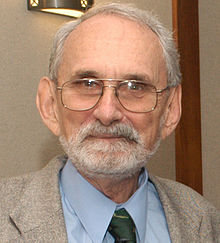![]() Robert Floyd Curl, Jr.
(born August 23, 1933) is a University Professor Emeritus,
Pitzer-Schlumberger Professor of Natural Sciences Emeritus, and
Professor of Chemistry Emeritus at Rice University.
Robert Floyd Curl, Jr.
(born August 23, 1933) is a University Professor Emeritus,
Pitzer-Schlumberger Professor of Natural Sciences Emeritus, and
Professor of Chemistry Emeritus at Rice University.
He was awarded the Nobel Prize in Chemistry in 1996 for the discovery of the nanomaterial buckminsterfullerene, along with Richard Smalley also of Rice University, and Harold Kroto of the University of Sussex.
Born in Alice, Texas, United States, Curl was the son of a Methodist minister. Due to his father's missionary work, his family moved several times within southern and southwestern Texas, and the elder Curl was involved in starting the San Antonio Medical Center's Methodist Hospital. Curl attributes his interest in chemistry to a chemistry set he received as a nine-year-old, recalling that he ruined the finish on his mother's porcelain stove when nitric acid boiled over onto it. He is a graduate of Thomas Jefferson High School in San Antonio, Texas. His high school offered only one year of chemistry instruction, but in his senior year his chemistry teacher gave him special projects to work on.
Curl received a B.S. from Rice Institute (now Rice University) in 1954. He was attracted to the reputation of both the school's academics and football team, and the fact that at the time it charged no tuition.[5] He earned his Ph.D. in chemistry from the University of California, Berkeley, in 1957. At Berkeley, he worked in the laboratory of Kenneth Pitzer, then dean of the College of Chemistry, with whom he would become a lifelong collaborator. Curl's graduate research involved performing infrared spectroscopy to determine the bond angle of disiloxane.
Curl was a postdoctoral fellow at Harvard University with E. B. Wilson, where he used microwave spectroscopy to study the bond rotation barriers of molecules. After that he joined the faculty of Rice University in 1967. He inherited the equipment and graduate students of George Bird, a professor who was leaving for a job at Polaroid. Curl's early research involved the microwave spectroscopy of chlorine dioxide. His research program included both experiment and theory, mainly focused on detection and analysis of free radicals using microwave spectroscopy and tunable lasers. He used these observations to develop the theory of their fine structure and hyperfine structure, as well as information about their structure and the kinetics of their reactions.
Curl's research at Rice involved the fields of infrared and microwave
spectroscopy. Curl's research inspired Richard Smalley to come to Rice
in 1976 with the intention of collaborating with Curl. In 1985, Curl was
contacted by Harold Kroto, who wanted to use a laser beam apparatus
built by Smalley to simulate and study the formation of carbon chains in
red giant stars. Smalley and Curl had previously used this apparatus to
study semiconductors such as silicon and germanium. They were initially
reluctant to interrupt their experiments on these semiconductor
materials to use their apparatus for Kroto's experiments on carbon, but
eventually gave in.
They indeed found the long carbon chains they were looking for, but also
found an unexpected product that had 60 carbon atoms.[9] Over the course
of 11 days, the team studied and determined its structure and named it
buckminsterfullerene after noting its similarity to the geodesic domes
for which the architect Buckminster Fuller was known. This discovery was
based solely on the single prominent peak on the mass spectrograph,
implying a chemically inert substance that was geometrically closed with
no dangling bonds. Curl was responsible for determining the optimal
conditions of the carbon vapor in the apparatus, and examining the
spectrograph. Curl noted that James R. Heath and Sean C. O'Brien deserve
equal recognition in the work to Smalley and Kroto.The existence of this
type of molecule had earlier been theorized by others, but Curl and his
colleagues were at the time unaware of this. Later experiments confirmed
their proposed structure, and the team moved on to synthesize endohedral
fullerenes that had a metal atom inside the hollow carbon shell. The
fullerenes, a class of molecules of which buckminsterfullerene was the
first member discovered, are now considered to have potential
applications in nanomaterials and molecular scale electronics. Robert
Curl's 1985 paper entitled "C60: Buckminsterfullerine", published with
colleagues H. Kroto, J. R. Heath, S. C. O’Brien, and R. E. Smalley, was
honored by a Citation for Chemical Breakthrough Award from the Division
of History of Chemistry of the American Chemical Society, presented to
Rice University in 2015.The discovery of fullerenes was recognized in
2010 by the designation of a National Historic Chemical Landmark by the
American Chemical Society at the Richard E. Smalley Institute for
Nanoscale Science and Technology at Rice University in Houston, Texas.
After winning the Nobel Prize in 1996, Curl took a quieter path than
Smalley, who became an outspoken advocate of nanotechnology, and Kroto,
who used his fame to further his interest in science education, saying,
"After winning a Nobel, you can either become a scientific pontificator,
or you can have some idea for a new science project and you can use your
newfound notoriety to get the resources to do it. Or you can say, 'Well,
I enjoy what I was doing, and I want to keep doing that
Curl's later research interests involved physical chemistry, developing
DNA genotyping and sequencing instrumentation, and creating
photoacoustic sensors for trace gasses using quantum cascade lasers. He
is known in the residential college life at Rice University for being
the first master of Lovett College.
Curl retired in 2008 at the age of 74 becoming a University Professor Emeritus, Pitzer-Schlumberger Professor of Natural Sciences Emeritus, and Professor of Chemistry Emeritus at Rice University.
Curl married Jonel Whipple in 1955, with whom he had two sons.
Bridge lovers Curl has been an ACBL member for decades.

